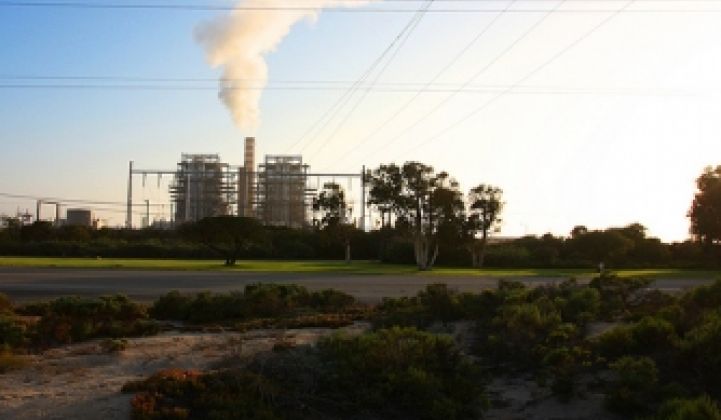Capturing coal plant carbon emissions using chilled ammonia – it's working. Now the question is how to store that captured carbon dioxide.
That's the gist of a Thursday report that Alstom Power's carbon capture technology has captured 90 percent of the carbon dioxide from a We Energies coal plant in Pleasant Prairie, Wisc.
That's in line with earlier results from the chilled ammonia technology, which has been running at the Wisconsin plant since last year. Alstom is testing the same technology in 10 pilot projects around the world.
The pilot projects include utility American Electric Power's 1,300-megawatt Mountaineer Plant, which earlier this month started a first-ever test of not only capturing coal plant carbon emissions but also injecting the carbon dioxide into underground caverns (see New York Times).
Other projects around the word are injecting CO2 underground, but those are doing so at pilot plants rather than full-scale operating coal plants. Most also inject CO2 to improve oil and gas field production, rather than solely to keep the carbon from entering the atmosphere (see Vattenfall to Trap Carbon Emissions).
But coal plants, which create about half the world's CO2 emissions, will need to start capturing and storing their emissions in a big way if they're to reduce their share of contribution to global warming.
The International Energy Agency reported this week that the world will need to invest $10 trillion in a wide range of new energy technologies to meet a goal of cutting global emission in half by 2050 – something the agency says is critical to forestalling dangerous climate change (see Bloomberg).
Of course, that includes everything from lower-emission vehicle fleets to large-scale solar, wind, geothermal and nuclear power plants.
But coal-fired power plants will still make up a significant portion of the world's electricity generation for the foreseeable future, according to a study by the utility-funded nonprofit Electric Power Research Institute (see EPRI: CO2 Cuts Will Cost a Lot More Without Nuclear and Clean Coal).
EPRI has said that the United States will have to convert about 60 gigawatts worth of the country's existing 300 gigawatts or so of coal-fired power plants with carbon capture and storage technology, as well as include it in about 35 gigawatts or so of new coal-fired power plants, to keep overall costs of reducing emissions at a lower level.
Just how much that will add to the price of coal-fired power remains an open question. Alstom and We Energies executives in a Thursday press conference said the Pleasant Prairie project cost about $8 million.
But they declined to project how much carbon capture and storage might add to the costs of producing power at a larger scale, saying they weren't ready to extrapolate those potential future costs from the pilot project.
EPRI studies show that power generated by coal plants with carbon capture and storage, if brought to full scale, "ends up with a price of electricity that is very comparable to other options going forward," such as nuclear power, said Hank Courtright, senior vice president at EPRI.
But the challenges of capturing and storing carbon at those scales remain daunting.
The first step is capturing the carbon. The Department of Energy's $1.4 billion Clean Coal Power Initiative has seen applications from Duke Energy, NRG, Southern Co. and American Electric Power Co., and other utilities seeking ways to do that (see Duke Leaves Clean Coal Group).
Beyond chilled ammonia systems, so-called advanced amine carbon capture technology now being tested by utility Southern Co. and Mitsubishi Heavy Industries shows promise, EPRI's Courtright said.
As for storing carbon emissions, pumping them underground remains the most promising and cost-effective means of keeping it from entering the atmosphere (see Carbon Capture: Possible Solution Part I, II, III and IV).
Underground storage is the focus of the Department of Energy's FutureGen Alliance, a multi-utility carbon capture project revived this year after being canceled by the Bush Administration for cost overruns (see DOE Gives Go Ahead for FutureGen to Be in Illinois).
DOE has also given $27.6 million to 19 projects seeking to determine the risks of storing captured carbon underground (see Feds Pump Cash Into Carbon Storage).
Wisconsin's geology doesn't support large-scale underground storage, so We Energies has been "capturing and releasing" the carbon dioxide from Alstom's system, Gale Klappa, the utility's CEO and president, said Thursday.
In the future, the utility envisions a pipeline system that could carry captured carbon dioxide to states that do have underground storage capacity, Klappa said.
EPRI envisions a nationwide system of carbon dioxide pipelines, much like those that now carry natural gas around the country, being an integral part of a national carbon storage strategy, Courtright said.
Other technologies for storing carbon remain more elusive and experimental.
Utility Arizona Public Service has received a $70.5 million Department of Energy grant to try feeding captured carbon to algae at its Cholla Generating Station in northeastern Arizona, and algae-to-biofuel company Origin Oil said last month that it was seeking grants for a project that would see captured carbon fed into algae ponds (see APS Gets $70.5M to Feed Captured Carbon to Algae).
Photo of a coal-fired plant via Rennett Stowe / Creative Commons.



